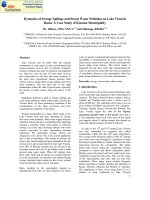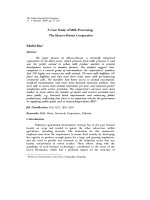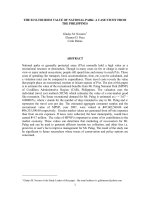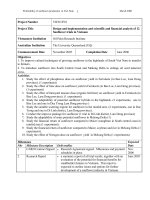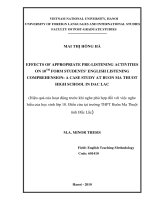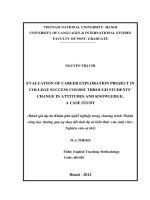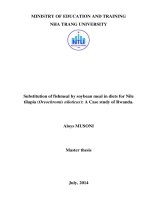Does remittance affect on behaviour of households a case study of 12 rural provinces in vietnam
Bạn đang xem bản rút gọn của tài liệu. Xem và tải ngay bản đầy đủ của tài liệu tại đây (7.82 MB, 171 trang )
UNIVERSITY OF ECONOMICS
HO CHI MINH CITY
VIETNAM
INSTITUTE OF SOCIAL STUDIES
THE HAGUE
THE NETHERLANDS
VIETNAM - NETHERLANDS
PROGRAMME FOR M.A IN DEVELOPMENT ECONOMICS
DOES REMITTANCE AFFECT ON BEHAVIOUR OF
HOUSEHOLDS? A CASE STUDY OF TWELVE RURAL
PROVINCES IN VIETNAM
BY
NGUYỄN NGÔ PHƯƠNG DIỆP
MASTER OF ARTS IN DEVELOPMENT ECONOMICS
HO CHI MINH CITY, October 2014
UNIVERSITY OF ECONOMICS
HO CHI MINH CITY
VIETNAM
INSTITUTE OF SOCIAL STUDIES
THE HAGUE
THE NETHERLANDS
VIETNAM - NETHERLANDS
PROGRAMME FOR M.A IN DEVELOPMENT ECONOMICS
DOES REMITTANCE AFFECT ON BEHAVIOUR OF
HOUSEHOLDS? A CASE STUDY OF TWELVE RURAL
PROVINCES IN VIETNAM
A thesis submitted in partial fulfilment of the requirements for the degree of MASTER
OF ARTS IN DEVELOPMENT ECONOMICS
By
NGUYỄN NGÔ PHƯƠNG DIỆP
Academic Supervisor:
Dr. PHẠM THỊ THU TRÀ
HO CHI MINH CITY, October 2014
DECLARATION
This is to certify that the substance of this thesis entitled “Does remittance
affected on behaviour of households?: A case study of twelve rural provinces in
Vietnam”, which is submitted by me in fulfillment of requirements for the degree of
Master of Art in Development Economic to the Vietnam – The Netherlands
Programme.
I certify that to best of my knowledge, any help received in preparing this thesis,
and all sources used, have been acknowledged in this thesis.
Nguyễn Ngô Phương Diệp
3
ACKNOWLEDGMENT
First of all, I would like to express my greatest appreciation to my supervisor,
Dr. Phạm Thị Thu Trà, for her advices, instructions and comments, patient guidance, as
well as encouragement with all her heart during the time of studying and doing this
thesis. Without her guidance, I could not implement and complete my thesis.
I also would like to offer my special thanks to Dr.Phạm Khánh Nam and
Lecturer Lê Anh Khang for the valuable suggestions and materials that help me to
develop this thesis.
In addition, I would like to special thanks to all the lecturers at the Vietnam –
Netherlands Program for their knowledge of all the courses during I studied at the
program.
Besides my mentors, I would like to thank my friends who are always beside me
and support for my thesis.
Last, but not least, I am very deeply grateful to my family. Without their warm
encouragement, support, and attention, I would not be possible to complete this
dissertation.
4
ABBREVIATIONS
ATE
Average Treatment Effect’
ATT
Average Treatment effect on the Treated
BPM
Balance of Payment Manual
DID
Difference in Difference
FDI
Foreign Direct Investment
FEM
Fixed-Effect Model
IMF
International Monetary Fund
NPISH
NonProfit Institutions Serving Household
ODA
Official Development Assistance
OLS
Ordinary Least Square
PSM
Propensity Score Matching
TFP
Total Factor Productivity
USD
United States Dollar
VHLSS
Vietnam Household Living Standard Survey
VARHS
Vietnam Access to Resources Household Survey
WB
World Bank
5
ABSTRACT
During the past decades, remittance becomes a new capital source in developing
countries. This capital flow which is increasing every year in the developing countries
derived from origins such as exporting labors, or migration from countries with low
income to countries with medium or high income. Remittance considered the stable
capital flow for economic growth to labor exporting countries or countries with huge
migration, helps reducing poverty through increasing income of households. Until
1986, in most cases remittance received by households living in Ho Chi Minh city in
Viet Nam, after 1986 remittance inflow is expanded to households living in rural areas
of Viet Nam by labor exporting policy. Up to now, remittance is increasing more and
more, and it is also one of tools to alleviate poverty, and to enhance living condition of
Viet Nam households. So, the aim of this study will examine the effect of remittance on
behaviours of households receiving remittance in rural Vietnam. Estimation of this
effect based on impact evaluation method and data set of Vietnam Access to Resources
Household Survey (VARHS) in 2006, 2008, and 2010. This data set was carried out by
Institute of Labor and Social Sciences, a subsidiary of Ministry of Labor-Invalids and
Social Affairs, in 12 rural provinces in North, Middle and South of Viet Nam such as
Ha Tay, Lao Cai, Phu Tho, Lai Chau, Dien Bien, Nghe An, Quang Nam, Khanh Hoa,
Dak Lak, Dak Nong, Lam Dong, Long An.
6
TABLE OF CONTENTS
DECLARATION............................................................................................................ 3
ACKNOWLEDGMENT................................................................................................4
ABBREVIATIONS........................................................................................................5
ABSTRACT................................................................................................................... 6
TABLE OF CONTENTS...............................................................................................7
LIST OF TABLES..........................................................................................................9
LIST OF FIGURES...................................................................................................... 10
1. 1
1. 2
1. 3
1. 4
1. 5
1. 6
1. 7
PROBLEM STATEMENT..................................................................................... 11
RESEARCH OBJECTIVE..................................................................................... 14
RESEARCH QUESTION...................................................................................... 14
SCOPE.............................................................................................................. 14
DATA................................................................................................................ 16
METHODOLOGY............................................................................................... 16
THESIS OUTLINE............................................................................................... 16
CHAPTER II - THEORETICAL FRAMEWORK....................................................... 18
2. 1 RELEVANT CONCEPTS AND BROADER ISSUES OF CONCERN...............................18
2. 1.1 Remittance................................................................................................... 18
2.1.2 Literature of migration and remittances....................................................... 19
2.1.3 Theory of Remittances................................................................................ 23
2. 2 LITERATURE REVIEW: REMITTANCES, INCOME, SAVINGS, ASSET, INSURANCE
AND BORROWING ........................................................................................................ 26
2. 3 SUMMARY OF LITERATURE REVIEW .................................................................. 33
2. 4 CONCEPTUAL FRAMEWORK .............................................................................. 35
CHAPTER III - RESEARCH METHODOLOGY ........................................................ 36
3. 1 PROPENSITY SCORE MATCHING ........................................................................ 36
3.1.1 Assumptions of PSM method ....................................................................... 37
3.1.2 Model Specification of Propensity Score Matching ..................................... 38
3.1.3 Software ........................................................................................................ 44
3. 2 DIFFERENCE IN DIFFERENCE (DD) METHOD .................................................... 44
7
3.2.1 Theory ...........................................................................................................
3.2.2 Implementing DID ........................................................................................
3.2.3 Model of this study .......................................................................................
3.3 COMBINING PSM WITH DID METHODS .............................................................
3.4 DATA .................................................................................................................
CHAPTER IV - EMPIRICAL ANALYSIS ...................................................................
44
45
46
50
51
55
4. 1 DESCRIPTIVE ANALYSIS OF THE SAMPLE........................................................... 55
4. 2 EMPIRICAL RESULTS..........................................................................................
4. 2.1 Propensity score matching (PSM) model .....................................................
4. 2.2 DID model ....................................................................................................
4. 2.3 Combining PSM Method and DID Method .................................................
CHAPTER V - CONCLUSIONS AND RECOMMENDATIONS ...............................
58
58
63
68
72
5. 1 CONCLUSIONS ................................................................................................... 72
5. 2 LIMITATIONS AND SUGGESTIONS FOR FURTHER RESEARCHES .......................... 73
REFERENCES ............................................................................................................... 74
APPENIX A. REMITTANCES DEFINED IN BALANCE OF PAYMENT OF
INTERNATIONAL MONETARY FUND. ................................................................... 80
APPENDIX B. QUESTIONNAIRE .............................................................................. 84
APPENDIX C. PROPENSITY SCORE MATCHING METHOD ............................... 91
APPENDIX D. DIFFERENCE IN DIFFERENCE METHOD ................................... 127
APPENDIX E. PSM AND DID METHODS .............................................................. 147
8
LIST OF TABLES
Table 3.1 Variables of Propensity score Matching....................................................................... 41
Table 3.2 Population in each province.............................................................................................. 42
Table 3.3 Weight of Population in VARHS 2006, VARHS 2008 and VARHS 2010 .. 42
Table 3.4 Variables of Difference in Difference Method........................................................... 49
Table 3.5 DID estimation between treatment group and control group............................... 50
Table 4. 1 Number of HHs receiving remittance and receiving no remittance.................55
Table 4. 2 Summary of Households with and without remittance......................................... 56
Table 4.3 Expected sign in PSM Model........................................................................................... 57
Table 4.4 Expected sign of variables in DD model..................................................................... 58
Table 4.5 Summary of Average Treatment Effect of on Treated Group............................... 62
Table 4.6 Summary the impacts of remittance by PSM method............................................. 63
Table 4.7 Results of DID Method in 2006/2008........................................................................... 66
Table 4.8 Results of DID Method in 2008/2010........................................................................... 67
Table 4.9 Results of PSM - DID Method in 2006/ 2008........................................................... 70
Table 4.10 Results of PSM – DID Method in 2008/2010......................................................... 71
9
LIST OF FIGURES
Figure 1. 1 Global Remittances Inflow............................................................................................ 11
Figure 1. 2 ODA, FDI and Remittance in Viet Nam from 2000 to 2011............................. 13
Figure 2. 1 Neo-classical mechanism leading to equilibrium................................................. 20
Figure 2. 2 Motives for Remittances.............................................................................................. 26
Figure 3. 1 Example of Common Support...................................................................................... 38
Figure 3. 2 An example of Difference in Difference................................................................... 46
10
DOES REMITTANCE AFFECT ON BEHAVIOUR
OF HOUSEHOLDS?
A CASE STUDY OF TWELVE RURAL PROVINCES IN VIETNAM
CHAPTER I - INTRODUCTION
1. 1Problem Statement
Increasing remittance during the past decades revealed as the special
phenomenon in developing countries. According to World Bank’s statistical figures
indicated, that remittance has been quickly increasing over the past decades. In 1990,
global flow of remittance is from 68 billion USD, up to 131 billion USD in 2000, and
440 billion in 2010 as in Figure 1.1. This is an important source of external capital
contributing to economic growth and development as well as reducing poverty of
households in developing countries. Stemming from remittance, working papers
studied positive or negative effects of remittance on income, asset, borrowing and
saving as mentioned below supplying empirical evidences in developing countries.
Figure 1. 1 Global Remittances Inflow
Source: Migration Policy Institute, World Bank, 2011.
11
Since the policy of “Doi moi” in 1986 and the even more radical market-oriented
reform of 1989, Viet Nam has been considered the country with high economic growth.
Average Gross Domestic Production growth in Vietnam is 7.6% during period 20002007 (data of World Bank, 2013). The factors have contributed for economic growth
including capital, labor, and Total Factor Productivity (TFP), in which capital is count
for more than fifty percent. There are two kinds of capital such as foreign investment
and domestic investment. Foreign investment includes Foreign Direct Investment
(FDI) and Official Development Assistance (ODA), and domestic investment is
derived from saving of households, enterprises, and government. Household saving is
the major source of domestic investment and apart of household saving stems from
remittance.
According to World Bank (2011), Vietnam is ranked in top 20 remittance-receiving
countries in the world, and the second in East Asia & Pacific after Philippines.
Remittance flowing in Vietnam was increasing from 1.34 billion USD in 2000 to 8.6
billion USD in 2011. In comparison with Official Development Assistance (ODA) in
Vietnam, remittance has been more increasing and higher than ODA since 2002 to now,
and remittance was higher than Foreign Direct Investment (FDI) in 2010 and 2011
(Figure 1.2).
Remittance is increasing year by year and becomes a stability finance for income
smoothing, as well as economic growth in developing countries and Viet Nam
particularly, during the past decades. Remittance inflow in Viet Nam is derived from
two sources including Vietnamese immigrant and labor exporting. Before 2000, Viet
Nam received remittances from Vietnamese immigration to the United States between
1971 and 2001 (Wade D.P, 2008). Since 1994, remittances have been sent by
Vietnamese workers in developed countries. Labor exporting in Viet Nam is policy of
Government; in particular, the Law and regulations encourage labor exporting for
purposes such as creating jobs, stabilizing social security, enhancing standard living,
12
and poverty reduction in provinces of Viet Nam. The beginning is Conference
th
Resolution of Party Central Committee No.02/NQ-HNTW dated December 24 , 1996
mentioned training skilled workers for industrial zones, export processing zones, taking
into account the demand for labor export. The next is Law No. 72/2006/QH11 dated
th
November 29 , 2006 of Government promulgating Law on Vietnamese guest workers;
th
and in particular Decision No.71/2009/QD-TTg date April 29 , 2009 approved the
Project of supporting the poor districts for labor exporting to reduce sustainable
poverty in period 2009-2020. The latest is Instruction No.19-CT/TW dated November
th
5 , 2012 of Viet Nam Party Central Committee on enhancing the Party's leadership to
train vocation for rural workers.
Figure 1. 2 ODA, FDI and Remittance in Viet Nam from 2000 to 2011
Source: World bank (2012).
13
Remittance is increased rapidly by Labor exporting policy of Viet Nam
Government, however, the households having members attending labor exporting
whether changing being better than not attending, especially in rural provinces. Based
on these literatures and empirical evidences, the aim of this study considers connection
of remittance and its influence on rural receiving-remittance households in Vietnam.
1. 2Research Objective
Based on mentioned above concerns, the thesis was carried out for the purpose
exploring whether or not there were any effect of remittance on behaviour of
households receiving-remittance in Vietnam rural, based on a comparison between
households with and without remittances. By applying research result to reality and
based on collected data, the thesis will then suggest the recommendation relating how
to use remittances to improve living condition in rural households.
1. 3Research Question
By limiting the objective of this research to twelve provinces in rural Viet Nam,
this thesis tried to outline the income receiving-remittance and receiving-no remittance
rural households. Specifically, we tried to find the answers to the question “How is
effect of remittance on behaviour of rural households receiving remittance in
Vietnam?”
1. 4
Scope
For the recent decades, remittance inflow becomes diverse in Viet Nam, it is not
only focus on big cities as Ho Chi Minh city and Ha Noi city but also move to other
urban and rural areas, and origins of foreign remittances derived not only from
immigrating relatives of households but also from exporting labor.
The economic globalization and trade liberalization have led to free flows of
capital, goods, and human resource from countries to countries. The movement of
human resource across countries - known “exporting labor” - has brought significantly
14
economic value as well as social benefits to developing countries and Vietnam, in
particular.
The national policy of Viet Nam always considers labor export as an important
factor of external economic to create jobs for laborers and reduce unemployment,
especially in rural provinces. There are a few studies of relationship between
remittance and welfare (Nguyen Viet Cuong, 2009), remittance and expenditures
(Wade Donald Pfau and Long Thanh Giang, 2010). These studies were major based on
Vietnam Household Living Standard Survey (VHLSS) datasets of 1990s, having in
comparison and extension for VHLSSs in 2002 and 2004. The question given “Is there
any effect of remittances on behaviour of remittance-receiving households in rural
provinces of Viet Nam?” To my knowledge, the earlier studies of remittances are based
on VHLSS data for all provinces and cities in Vietnam, and papers in particular for
impacts of remittance on rural households in Vietnam based on VARHS are rare.
Therefore, the purpose of this study presents changes income, borrowing, saving and
asset of receiving-remittance households and receiving-no remittance households in
rural provinces of Viet Nam. To pursue this purpose, we chose data sets of Vietnam
Access to Resources Household Survey (VARHS) in years of 2006, 2008 and 2010.
VARHS has designed to provide the information collected by the General Statistical
Office (GSP) under the umbrella of the Vietnam Household Living Standard Survey
(VHLSS) every two year. VARHS datasets were surveyed by Institute of Labor and
Social Sciences, subsidiary unit of Ministry of Labor - Invalids and Social Affairs, in
twelve rural provinces of Viet Nam including: Ha Tay, Lao Cai, Phu Tho, Lai Chau,
Dien Bien, Nghe An, Quang Nam, Khanh Hoa, Dak Lak, Dak Nong, Lam Dong, and
Long An.
15
1. 5
Data
Due to limitation of our capacity in collecting data, and limited information on
this topic in Vietnamese context, we will use secondary data VARHSs collected by
Institute of Labor and Social Sciences to serve for the research, conclusion, and
recommendation in this thesis.
1. 6
Methodology
This study was implemented to find the effects of remittances on receiving
remittance households by means of comparison with receiving no remittance
households in provinces of North, Centre, and South of Viet Nam. Descriptive analysis
was applied to explore receiving-remittance households surveyed in years of 2006,
2008, and 2010. We used models of Propensity Score Matching (PSM), Difference in
Difference (DID), and PSM combining with Difference in Difference implemented by
OLS regression and Fixed-effect model (FEM) to explain the different effects of
remittances on receiving-remittance and receiving-no remittance households. Then, we
applied Stata software to process data collected and to approach the problem based on
estimating a multivariate regression model, given the linkages among many of
explanatory variables to be used.
1. 7Thesis outline
The next, Chapter II will present theoretical links and literature review of
previous studies relating to connection between remittance with saving, asset, loan,
insurance, and income. In this chapter also will focus on the main concern of
remittances and change in behaviour of receiving-remittance households. Chapter III
will discuss specification of model used in analyzing the data. Chapter IV will present
and interpret the empirical analysis results of the models. Finally, Chapter V will
present the conclusions and recommendations. In this chapter, our remarks, findings,
16
and limitations raised during the survey process will be presented. Finally, several
recommendations for future research will be offered.
17
CHAPTER II - THEORETICAL FRAMEWORK
This chapter will present concepts, broad issues, and theory of remittance including:
(i) Section 1 presents concepts and broader issues of remittance. (ii) Section 2 shows
literature of linking between migration and remittance based on economic theories
such as Neo-classical theory, Keynesian theory, Developmentalist theory, Dual Labor
market theory, The New Economics of Labor migration, and Social Network Theory.
(iii) Section 3 lists the empirical studies relating to remittance with income, saving,
borrowing, and assets. (iv) The last one is for presenting briefly literature review.
2. 1 Relevant concepts and broader issues of concern
2. 1.1 Remittance
According to Maimbo and Ratha (2005) and Jeffrey H. Cohen et al (2012),
remittances are economic transfers to stem from an immigrant to their sending country
and households. Richards H. Adams (1991) mentioned international remittances as
money and goods sent to families by individuals working abroad, and remittances
affects significantly on the balance of payment in countries receiving remittances.
Besides, Adams and Page (2003), Anne Harrison (2004) and Jens Reinke (2007)
presented workers’ remittances as certain transactions derived from individuals living
or working abroad or related to their migration. In Balance of payments Manual of
International Monetary Fund, the Fifth Edition (PBM5) in 1993, the term of remittance
involves Wokers’ remittances. It is relative to current transfers from migrants including
people come and stay in foreign countries for more than a year or less than a year.
Enclosed workers’ remittance is two supplementary items cover “compensation of
employee” and “migrants’ transfers”. Compensation of employee covers wages,
salaries, and other benefits in terms of cash or in kind paid for people who work in
countries being different their native country. They considered as seasonal or other
18
short-term workers meaning less than a year. Migrants’ transfers term is flows of goods
and changes in financial items stemmed from the migration (residence for more than a
year). In 2009, International Monetary Fund published Balance of Payments and
International Investment Positional Manual – Six Edition (BPM6) to modify
conceptual limitations of remittance definitions in BPM5. At first, term of “workers’
remittance” replaced by “Personal transfers”. The next, supplementary items related to
remittances such as “Personal remittances”, ‘Total remittances” and “Total remittances
and transfers to Nonprofit Institutions Serving Households (NPISHs)”. In there,
Personal transfers cover all current transfers in cash or in kind made or received by
resident households to or from nonresident households. Term of “personal remittances”
includes personal transfers, compensation of employees, and capital transfers. The next
is “Total remittances” comprising “Personal remittances and Social benefits”. The last
term is Total remittance and transfers to Nonprofit Institutions Serving Households
(NPISHs) defined as a sum of “Total remittances, Current transfers to NPISHs, and
Capital transfers to NPISHs” - Appendix A.
2.1.2 Literature of migration and remittances
One of international capital flows interested in last decades is remittance. This is
new transmission channel of capital taking place after migration phenomenon, it
contributes to economic growth in developing countries, and it is a tool for
development in labor exporting countries. The concept of remittance has been linked to
migration theory. According to Yoko Niimi et al (2006), there are causes and linkages
between migration and remittances, migration are often linked to remittances (IMF,
2009), Elke Holst et al (2010) stated that “standard economic theory of remittance is
based on the analysis of international labor migration. Within this context, labor
migration is usually motivated by labor income differences between the migrant’s
destination and home country”, as well as Hein de Haas (2007) considered remittances
19
and migration are rarely separate together. Due to the connection between remittances
and migration, there are many theoretical models built to explain this phenomenon.
Neoclassical theory: Macro and Micro Economics
The oldest theory of remittance and migration is Neo-classical theory. This theory
looked remittance and migration in two aspects including macro and micro aspects.
According to macroeconomics, migration happens in condition having non-equilibrium
in labor market, and the difference of wages. Labors in regions with abundant labor
and low wage will move to regions with scarce labor and high wage due. The result of
this movement is equilibrium of labor market. The following movement of labor is
capital flows including remittances to go in opposite direction from capital-rich to
capital poor countries (Massey et al, 1993 and Roel Jennissen, 2004 & 2007). The
mechanism leading to equilibrium Oberg (1995) is presented in Figure 2.1.
In microeconomics aspect, Neo-classical theory developed the explanation of
migration based on individual choice (Todaro, 1969). The high skill labors expect to
receive high real wages when moving to country with higher marginal productivity of
labor. They have to consider carefully the benefit and the cost when they decide to
migrate. The costs they pay including learning new language, costs of moving, looking
for their jobs, adapting to new labor environment, and so on. Massey et al (1993)
presented Borjas’ point of view (1990) regarding to migration behavior that is they
expected to get net return being higher when moving to alternative countries.
Figure 2. 1 Neo-classical mechanism leading to equilibrium
Low-wage region
High-wage region
Migration
Labour
Source: Oberg, 1995
Capital flows
Capital
20
Labour
Capital
Keynesian Theory
Keynesian theory (Roel Jennissen, 2007) gave the other view of migration and
remittance in comparison with Neo-classical theory. Keynes considered that migration
of labor stems from the difference of unemployment between regions. If there is the
difference of unemployment rate between regions, the labors in regions with high
unemployment rate will move to look for jobs in regions with low unemployment rate.
Behind the moving of labors is capital flows to pure their home.
Developmentalist Theory (1950s and 1960s)
This theory showed that large-scale capital transfer and industrialization to poor
countries would tend these countries’ economic towards rapid economic development
and modernization. Developmentalist “migration optimists” were partial towards think
that migration leads to a North-South transfer of investment capital and accelerates the
exposure of traditional communities to liberal, rational, and democratic ideas, modern
knowledge, and education. The policy of migration in developing countries started to
encourage emigration, the reason is that return migrants are expected to bring
remittances, skills, knowledge and experience to acquire abroad to contribute for
economic development in the country of origin (Hein de Haas, 2007).
Dual Labor Market Theory
In Dual labor market theory (Piore, 1979 and Massey et al, 1993), labor market is
separated into two sectors such as primary sector and secondary sector. The primary
sector requires capital-intensive methods, and the secondary requires labor-intensive
methods. As the results, there is a bifurcation of the labor force. In capital-intensive
sector, labors hold stable, skilled jobs with the best equipment and tool. In laborintensive sector, workers get unstable, unskilled jobs, meaning jobs at the bottom of the
labor market. They can be laid off at any time with no subsidize from employers.
21
Therefore, international or domestic migration becomes a measure of individual and
his family to cope with unemployment and poverty. Along with the flow of labor
moving among countries, there is flow of capital sent by share of migration workers’
earning back to their families/countries called remittance. Consequently, there is a
connecting migration and remittance.
In accordance with Dual labor market theory, we can be aware clearly linked
between migration and remittance in global economics context. Due to there is
shortage of labor in secondary sector in developed countries leading to moving labor
from developing countries to developed countries. Migration of labor motivates capital
flow from developed countries to developing countries that is remittances.
The New Economics of Labor Migration (NELM)
The new economics of labor migration (Hein de Haas, 2007 and 2008) has the
other vision in comparison with Neo-classical theory. NELM replaced the behavior of
individual migrants (in Neoclassical theory) based on the views of the family or the
household as the most appropriate decision-making unit. The risk-sharing behavior of
households are implemented by diversify income resources to minimize income risks
(Stark and Levhari, 1982) and maximum income. According to Lucas and Stark (1985)
and Hein de Haas (2007), households are conscious of migration to respond with
income risks due to migrant remittances serve as income insurance for households of
origin. This can explicate theoretically the reason of migration in case having no
substantial income differentials. Beside, migration plays a vital role in providing a
potential source of investment capital, which is especially important in the context of
the imperfect credit (capital) and risk (insurance) markets that prevail in the most
developing countries.
22
Social Network Theory
This theory presented social role of remittance that is social relationship in the
lives of the migrants and their households. Remittances were mentioned as resources to
use for exchanged between members of a social network. Social network is defined as
a set of recurrent association between groups of people linked by occupational,
familial, cultural, or effective ties. Resources are seemed as displaced to the social
network when a migrant sends remittances based on the following:
(i) Based on traditional or sentimental value, the migrant thought that they
accumulate social obligation from the people to whom they remit for example
childcare, sending goods.
(ii) The migrant remitting, maybe, conforms to moral values learn as being a member
of the group.
(iii) Remittances increase their social visibility in the sending and receiving countries,
in addition to avoiding the sanction by the social group if they do not remit.
2.1.3 Theory of Remittances
Pure Altruism
Affection of family is always intangible ties to members in a family. Regarding to
this relation, Lucas and Stark (1985 and 1988) explicated migrant’s motive for
remitting which is altruism. The migrants themselves feel to have their obligations to
transfer remittances because of a simple reason, the migrants care about the well-being
of their families, and the other reason that is their families’ support during their formal
education before and after leaving home. Regarding to altruism model, Rapoport and
Docquier (2005) also considered that the family sentiment is motive to impulse
migrants to remit their house. Migrants’ income increases, then remittances tend to
increase and vice versa. In addition, Glytsos (2001) stated that migrants’ remitting
purpose depends on length of time they reside abroad. If the migrant is resident
permanently abroad, they send remittance for altruistic motive, and if migrants live
23
abroad in short time (temporary), they tend to remit for purpose of investment and
future consumption. Moreover, Rapoport and Docquier (2005) reinforced link between
altruism and remittances based on demonstration of Funkhouser (1995) for a model of
remittance behaviour as follows.
“(i) Emigrants with higher earnings potential remit more;
(ii) Low-income household receiving more;
(iii) Remittances should increase with both the degree of proximity between the
migrant, and the remaining household members and the migrant’s intentions to return;
and
(iv) Remittances from a given migrant should decrease with the number of other
emigrants from the same household;
(v) The time profile of remittances should depend on the comparison between the
migrants’ time-discount factor and their earnings profile abroad”.
Pure Self-Interest
The contrary of pure altruism is impure altruism (pure self-interet). Lucas and
Stark (1985) gave three reasons to explicate motive of remitting without altruism from
the migrants to their families.
Firstly, a migrant would send money home to increase their visibility hence eligible
for inheritance, esteem or other resources in the community of origin.
Secondly, migrants send remittances in order to reimburse the household for past
expenditures such as schooling or the cost directly related to migration.
Lastly, in the case of pure self-interest, migrants have intended to return their
origin countries, this promotes to remit in order to purchase durable goods and invest
in housing, land, livestock or business at home.
24
Tempered Altruism or Enlightened Self-Interest
Lucas and Stark (1985)’s theory of “tempered altruism” or “enlightened selfinterest” was developed by El Mouhoub Mouhoud et al (2008), and Jessica HagenZanker et al (2007) stem from three motivations of remitting by means of family
arrangements such as exchange, insurance and investment.
- Exchange motive derived from migrants’ expectation for members in their family to
receive the better quality of welfare services (health, education, and so on) from their
remittances.
- Insurance motives are considered as intra-family arrangements between the migrant
and their families to diversify the risk of income volatility in rural regions. According
to Rapoport and Docquier (2005), families’ strategy is to dispose some members to go
abroad or urban to insure income of family in case of poor harvest, and all cost relating
to migrants paid by their families. These are motives the migrants to remit their family.
- Investment motive: the migrants transfer their saving to invest in their home countries
when they calculate potential return in their home countries being higher than in the
host countries. So, the remitting decision of migrants depends on the difference of
interest rate between home and host countries.
In general, relationship between migration and remittances is explicited by
aspects including pure altruism, pure self-interest and tempered altruism. Motive of
migration is to remit to improve living conditions of members in a family, and three
motives for remittances summarized by Catalina Amuedo-Dorantes and Susan Pozo
(2006) in Figure 2.2.
25

